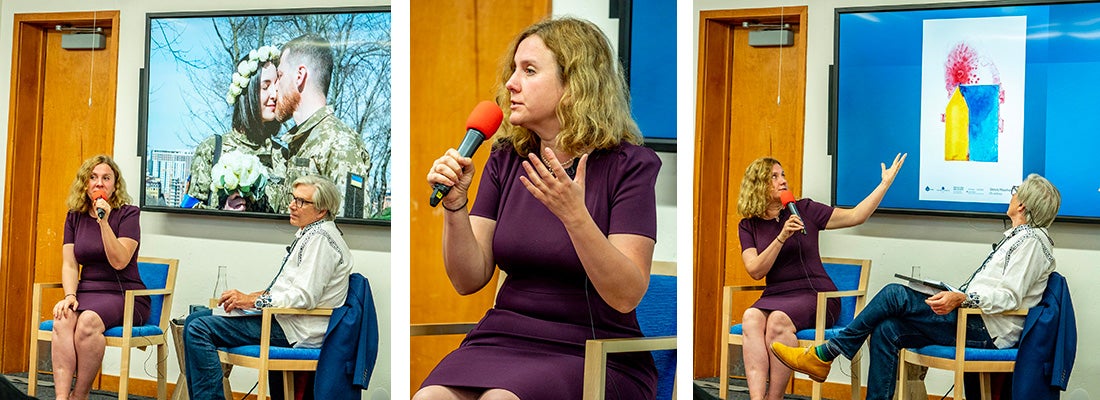The Aspen Institute, and its international partner, Aspen Institute Kyiv, wanted to share the story of Russia’s war on Ukraine, its ongoing effects, and its lasting aftermath with the world through the medium of Ukrainian art and artists. Together, they assembled “Beast of War, Bird of Hope,” a Ukrainian art gallery and exhibition held in the Koch building at the Aspen Meadows campus in Aspen, Colorado. This unique exhibition will run through Fall 2022 in Aspen, Colorado, and will potentially move to Washington, DC, in Fall 2022 through Winter 2022. The show is curated by Alisa Lozhkina, the former deputy director and chief curator at Mystetskyi Arsenal, the largest museum and exhibition complex in Ukraine. The artwork, which is almost entirely for sale, features different forms of media including paintings, watercolors, photography, digital prints, and three-dimensional art from twelve leading Ukrainian artists.
Aug 17, 2022 Bird of Hope Art and discussion Matt Power Photography


Below is a message on the exhibit from our curator, Alisa Lozhkina:
“Russia’s invasion of Ukraine, a sovereign state, began back in 2014 with the annexation of Crimea and the start of Moscow’s orchestrated hybrid conflict in the Donbas. Yet it was not until February 24, 2022, that most of the world realize the destructive power of Russia’s conflict.
Within weeks, tens of thousands of Ukrainians died, millions more became refugees and internally displaced people, cities were destroyed, and society became traumatized for generations to come. For eight years, Ukraine has lived in a state of anxiety and uncertainty. Ukrainian artists of today have captured these feelings and conveyed them in such a way that demonstrates the pain, strength, and hope of the people.
The art exhibition, now displayed at the Institute’s Aspen Meadows campus, includes works by twelve leading Ukrainian artists who have taken influence from the war. The centerpiece of the exhibition is a large-scale painting “The Uncertainty” by Olena Naumenko. The painter created this work thousands of kilometers away from home in Poland where she and her daughter are now refugees. Naumenko’s piece captures two figures embracing, protecting each other from fear and despair which are familiar feelings for millions of Ukrainians today.
Another large part of the exhibition’s collection is war diaries. Kinder Album and Danylo Movchan from Lviv and Igor Gusev from Odesa, present their daily sketches that garnered significant attention across social media and in both Ukrainian and international press during the first months of the war. The exhibition also includes several works that were created in 2014-2022, when the war in eastern Ukraine was already underway. The video, by Piotr Armianovski, and performance documentation, by Maria Kulikovska, tell the story of Mariupol, an industrial city on the Sea of Azov. From 2014-2022, Mariupol was dangerously close to the frontline zone but continued with daily life, even though many contemporary art centers opened their doors. However, in February-May this year, Mariupol was almost completely destroyed by Russian troops.
The exhibition features the work of two Ukrainian photographers. The first photographer, Aleksandr Chekmenev, became famous for his reporting for The New York Times and three recent covers of Time magazine. The second photographer, Efrem Lukatsky, is a courageous man and photographer. He has been with the Associated Press for 30 years, photographing conflict zones in Chechnya, Afghanistan, and Syria. Now the war has come to Lukatsky’s home. Since the early days of the war, he has been on the frontlines, documenting the people of Ukraine in their pain, resilience, and happiness.
The exhibition title was inspired by the works of Maria Prymachenko, one of the most famous Ukrainian artists of the mid-20th century. During the first weeks of the war, Russian troops destroyed a museum where dozens of her works were kept. It was the first destruction of cultural heritage during the war. The news of the tragedy went around the world, and Prymachenko was suddenly noticed by the world’s leading curators and art journalists. Articles about her appeared in international newspapers and her works were included in the exhibition of the main project of the Venice Biennale. Tragedy unexpectedly gave a new impetus to the legacy of the remarkable Ukrainian artist.
World War II took the life of Maria Prymachenko’s husband and left their son an orphan. The artist hated the war with all her heart and feared its reoccurrence more than anything else. She created several anti-war works, including The Beast of War, presented at this exhibition. The second original work by Prymachenko in the Aspen Institute exhibition is Bird. A bird is an ancient image of hope and good news in Slavic folk art. I dream that soon the bird of hope will bring good news to Ukraine that is tortured by the beast of war.”
Alisa Lozhkina,
Exhibition curator
Alisa Lozhkina is an independent art critic and curator from Kyiv and is currently based in the San Francisco Bay Area. Between 2013 and 2017 Alisa served as Deputy Director and Chief Curator at Mystetskyi Arsenal, the largest museum and exhibition complex in Ukraine. From 2010 to 2016 she worked as Editor in Chief at major Ukraine art magazine ART UKRAINE. Alisa has curated numerous art projects in Ukraine and abroad and written several books, including Permanent Revolution: Art in Ukraine, XX–early XXI century, which was published in Ukrainian in 2019 and translated into English and French.
For questions about the exhibit, please email Danielle Baussan at danielle.baussan@aspeninstitute.org or Jonathon Price at jonathon.price@aspeninstitute.org.

